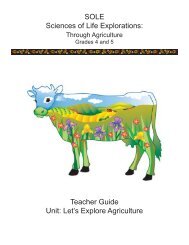Insect Anatomy - Agriculture in the Classroom
Insect Anatomy - Agriculture in the Classroom
Insect Anatomy - Agriculture in the Classroom
Create successful ePaper yourself
Turn your PDF publications into a flip-book with our unique Google optimized e-Paper software.
ADDITIONAL RESOURCES<br />
Bugs and O<strong>the</strong>r <strong>Insect</strong>s by Bobbie Kalman and Tammy Everts ISBN-10: 0-86505-713-3 ISBN-13:<br />
9-780865-057135<br />
Cornell University’s IPM Program: www.nysipm.cornell.edu (Request an educational trunk for your<br />
class!)<br />
SUPPLIES AND EQUIPMENT<br />
Crickets (pet supply stores commonly have<br />
crickets for sale approx. $ 0.10/ea)<br />
Clear conta<strong>in</strong>ers for circkets (with lids)<br />
Magnify<strong>in</strong>g glasses<br />
Books about <strong>in</strong>sects<br />
Ice cubes (optional)<br />
Pencils<br />
Craft wire<br />
Paper<br />
Pictures of various <strong>in</strong>sects<br />
Scissors<br />
Pipe cleaners<br />
Fea<strong>the</strong>rs<br />
Plastic beads<br />
Sequ<strong>in</strong>s<br />
Glue<br />
BACKGROUND FOR TEACHERS<br />
Bugs<br />
“Bug” is a term we use for many small creatures that crawl or fl y, many of <strong>the</strong>m <strong>in</strong>sects. However,<br />
not all bugs are <strong>in</strong>sects and not all <strong>in</strong>sects are bugs. Many of us do not like bugs or <strong>in</strong>sects,<br />
especially when <strong>the</strong>y surprise us <strong>in</strong> a chance encounter. The centipede is a good example. Ticks<br />
and mites look like <strong>in</strong>sects but on close <strong>in</strong>spection we see <strong>the</strong>y have eight legs. Millipedes look<br />
like <strong>the</strong> larvae of some moths, but hey are not true <strong>in</strong>sects, ei<strong>the</strong>r.<br />
<strong>Insect</strong> <strong>Anatomy</strong><br />
<strong>Insect</strong>s are arthropods, and so are mites, scorpions, crabs and centipedes. Arthropods are<br />
a group of animals with a hard exoskeleton, segmented bodies, and segmented appendages.<br />
There are some very basic facts that apply to <strong>the</strong> anatomy of all <strong>in</strong>sects, regardless of <strong>the</strong>ir highly<br />
<strong>in</strong>dividual characteristics. They have three major body regions; head, thorax and abdomen:<br />
three pairs of jo<strong>in</strong>ted legs; and most have w<strong>in</strong>gs for at least part of <strong>the</strong>ir life cycle. They have an<br />
exoskeleton on <strong>the</strong> outside ra<strong>the</strong>r than an endoskeleton on <strong>the</strong> <strong>in</strong>side. This exoskeleton is a<br />
hard but somewhat flexible outer shell, made of a prote<strong>in</strong> substance called chit<strong>in</strong> (pronounced KITE<strong>in</strong>)<br />
and no bones <strong>in</strong>side. Arthropods molt, or shed <strong>the</strong>ir exoskeleton, as <strong>the</strong>y grow.<br />
Body Regions<br />
The mouth, eyes and antennae are on <strong>the</strong> head of <strong>the</strong> <strong>in</strong>sect. Mouthparts vary among<br />
<strong>in</strong>sects; <strong>the</strong>y may be specialized for chew<strong>in</strong>g (grasshopper), spong<strong>in</strong>g (fl y), suck<strong>in</strong>g (butterfl y),<br />
or pierc<strong>in</strong>g and suck<strong>in</strong>g (aphid). The antennae are special feelers that do <strong>the</strong> work of a nose<br />
and hands - <strong>in</strong>sects use <strong>the</strong>ir antennae to smell food and to avoid enemies. The thorax is<br />
<strong>the</strong> centeral body region. The w<strong>in</strong>gs and all three pairs of legs are attached to <strong>the</strong> thorax, not <strong>the</strong><br />
abdomen. The abdomen is usually <strong>the</strong> largest part of <strong>the</strong> <strong>in</strong>sect.
















